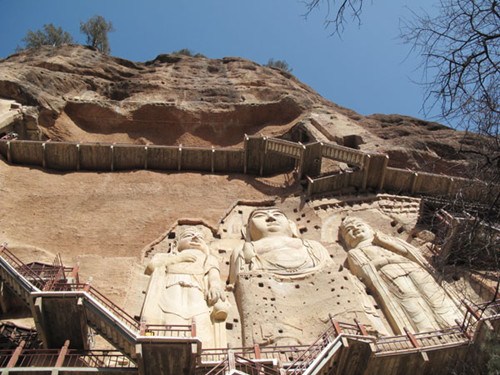
Three Buddha statues carved on the cliff surface are the highlights of Maiji's Buddhist heritage. Li Yang / China Daily
The story adds to the mysteries of the Buddha statues, making my trip more like an exploration for treasures.
The bright sunshine casts shadow on the large statue's face, and the moving shadow gives the still face different expressions.
This is the wisdom of ancient artists. They were good at making use of natural light and imagination to bring life to a still face.
Buddhism came to China through the Hexi Corridor along the Yellow River in Gansu province about 1,600 years ago, when ethnic groups from the north and the west came to central China in large migrations.
The religion born in India has gone to southeast and northeast Asia from China, despite its ups and downs.
The most popular Buddha is Amitabha, who is believed to be the chief Buddha of the Pure Land sect. Amitabha empowers all calling upon him to be reborn into his world, the Pure Land, where they receive all kinds of instruction by him and become bodhisattvas and Buddhas later.
This is the most prevalent school of Mahayana Buddhism during the first stage of Buddhism evangelization in China, when the three main Buddha statutes of Maiji Mountain were made.
There are many big holes beside the huge grotto of the three great statues, about 0.5 meters in diameter and about 1 meter deep.
It is said ancient workers first dug these holes and inserted solid tree trunks to form various working platforms, like scaffolds. The holes were also used by repairmen and painters in later times to construct their working platforms.
The climb up the stairs, passing by the great statues, felt like a walk through a museum.
On the cliff surface 50 to 70 meters above the mountain foot are scattered about 194 caves with more than 7,200 pieces of Buddha sculptures and more than 1,000 square meters of frescos remain on the inner surface of the caves.

Copyright ©1999-2011 Chinanews.com. All rights reserved.
Reproduction in whole or in part without permission is prohibited.